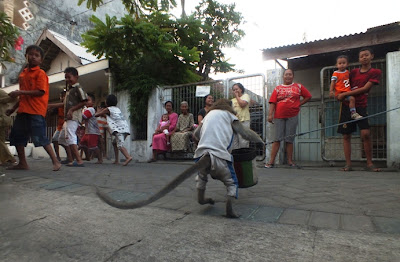It seems that Indonesia is becoming a place of reunions for me. I have no idea why, but a number of people I know are in the country at the moment and so I'm taking the opportunity to reconnect with them. Almost exactly 6 years after meeting Erika in a gorgeous guesthouse in Yazd I found her again in Indonesia's second city, Surabaya. At the time she and her partner Robin were cycling from Scotland east, with no definite goal in mind, seeing how far they could get and learning about the places along the way. They eventually ended up in Indonesia where Erika is now teaching English and quite content with her more stable situation: having a good job, a cosy house in a pleasant kampung and a circle of friends. I was glad to meet up with her again and catch up on what we had been up to in the intervening years and where we saw ourselves heading (much less clarity there). I was even introduced to some of her colleagues as they were celebrating a very British institution: after-work Friday drinks. It led to the bizarre situation where I was in the company of four other Scots, something that has probably only occurred once in the past 16 years since I left Aberdeen.
 |
| Monkey business in the kampung. Itinerant entertainers with a monkey on a chain and some music go round from neighbourhood to neighbourhood entertaining the kids with simple tricks. |
It seems strange that she has ended up in Surabaya, a city universally decried in Indonesia for being dirty, crowded and boring, much like Birmingham in the UK. Yes, the traffic is pretty bad and yes, it's never going to win any prizes for beauty, but scratch beneath the surface and you will find some quirky little gems. There's an important pilgrimage mosque buried deep inside the old town and surrounded by an Arab quarter where the tight market lanes, perfume stalls and shops selling all manner of Islamic paraphernalia make you feel as if you've stepped into a Syrian souq. Beached beside a canal is an old, ex-Soviet submarine that Indonesia bought second-hand. A pretty useless heap of metal, but the little hyper-nationalistic video that accompanies a visit is unintentionally hilarious in the extreme. A little out of town are the ruins of the once powerful Majapahit empire's capital. It was the swansong of Hindu power in the archipelago before succumbing to the advance of Islam in the late 15th century and, once again, precious little remains except for a few temple entrance portals that suggest at what once might have been.
 |
| All that remains of what must have once been a grand, Majapahit Hindu temple is this entrance portal set amidst rice fields. |
Mind you, don't scratch too far below the surface when around Surabaya or you may end up stuck in the mud. Literally. In 2006 a company drilling for gas in the Sidoarjo district south of Surabaya had a well blow out creating the world's biggest mud volcano that started spewing out tens of thousands of cubic metres of mud a day. The flow has been impossible to stop and continues to this very day. Three villages were completely engulfed by the rising tide of mud and the villagers had to be relocated. All that the authorities could do was hastily erect a dyke to try and contain the mud so that it wouldn't spread and cause further devastation. Of course, this being a developing country, there is plenty of controversy surrounding the event. The drilling company insists that the mud flow was due to an earthquake that occurred three days prior some 300km away. However most petroleum geologists put the blame entirely (or at least mostly) at the door of the drilling company and lax well casing practices. Be that as it may it won't change things for the poor people affected by the disaster because the company soon after filed for bankruptcy and left the government to foot the cleanup bill (malicious tongues may somehow imply that this was possible because one of the main shareholders was the government minister for economy and welfare at the time and is now leader of the main opposition party). It is now the dry season and the mud at the edges of the embankment are hard-baked, so I tested their relative solidity by venturing out a few metres before it started to give way and stopped, deciding caution to be the better part of valour.
I'm taking advantage of Erika's presence to leave my large rucksack with her and head off for a small tour of some more remote islands, namely Sulawesi and the Moluccas. In Sulawesi I finally met up with a friend I had not yet met, but with whom I had been in contact for several years, drawn together as we are by a fascination of the world's obscura. Horia has spent the last two years living in Indonesia on a scholarship to study the language and culture of the country. He has used his time here to travel the length and breadth of the archipelago and has seen countless fascinating places and, thanks to his ability to speak Indonesian, has been able to delve deeper than I ever will. (He has a blog, written in Romanian, but you can access the translated version here. Online translations are rather crude, but you can get a good idea of the main points.) Consequently he has become my inside source into where to find Indonesia's hidden eccentricities, which I hope to follow up on in my upcoming posts.
 |
| Horia looks none too pleased that I finally managed to track him down. Classic Oriental photo pose. |

2 comments:
what a small world, that or your popularity is increasing. :) Take care erik!
Good to see you two!
Post a Comment